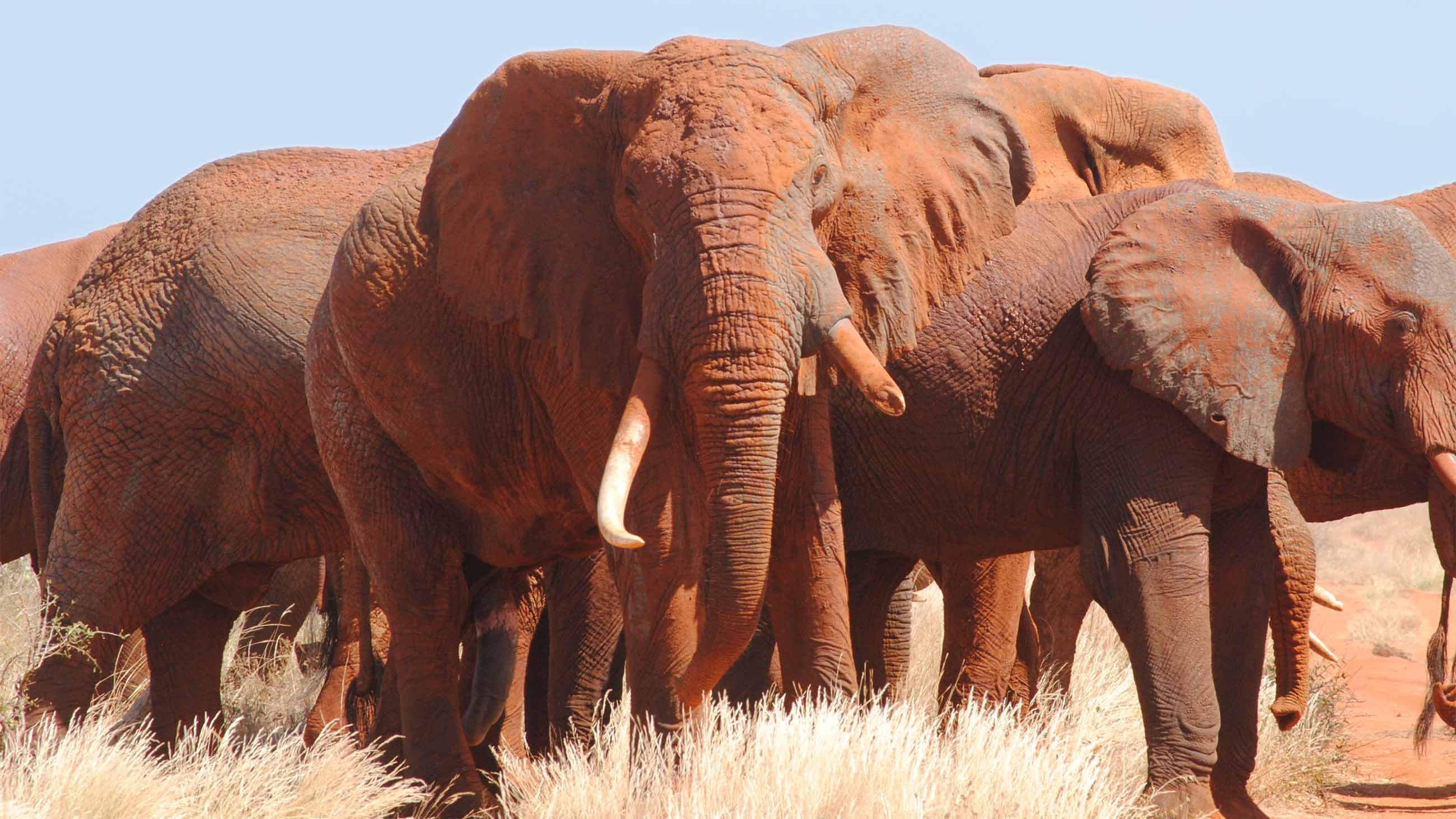In Kenya, a Transformation in Shades of REDD
Here is what a dead elephant looks like: Rib bones longer than my arm scattered across red dirt. Over here is a lower jaw, beached and desolate like the broken hull of a ship. Over there is the massive boulder of its skull. Behind the gaping eye sockets is a web of porous bone, a hideous honeycomb. Shreds of gray skin are strewn across the soil like filthy rags, and hyenas have dragged and scattered bits of the elephant’s remains over this final resting ground. The scavengers feast even on the bones, and they leave behind clumps of chalky dung that are vivid against the rust-colored soil.
Of course, the elephant’s tusks are gone, hacked off to be sold for more than $450 per pound.
A wildlife ranger clad in a forest-green uniform and black boots nudges the bones with a stick. He points out the rusted tip of a poacher’s arrowhead lying on the ground. It was dipped in poison so strong that just one can fell a 13,000-pound elephant. Traditionally, the poison came from the resin of Acokanthera schimperi — the poison arrow tree. These days, I’m told, poachers sometimes add cyanide to make the poison even more potent.
It’s been two months since the elephant was poached, but a fetid odor of decay lingers in the air. A ranger tells me that the smell of a rotting elephant can penetrate the soles of his boots for days, even weeks.
We drive a few miles away through a dry landscape covered with low brush and acacia trees forming wide parasols with their branches. Dirt tracks wind across the bush, and their routes seem indistinguishable as they stretch into the horizon. But for the rangers who patrol the area in and around Rukinga Sanctuary in southern Kenya, navigating the trails is second nature. The driver stops the jeep and we walk a short distance into the bush. This time, I smell the elephant before I see it. This carcass — a desiccated mass of hide and bone roughly shaped like an elephant — is fresher, still decomposing. I hold my breath then inhale and exhale slowly so I won’t gag from stench of decaying meat.
Four rangers approach and stand over the carcass. One of them picks up a stout stick and wedges it inside the corpse to pry it open. Skin and bones rip and creak, revealing rows of ribs neatly arranged like piano keys. Movement ripples along the skin’s interior. Thousands of maggots resembling black rice wiggle and squirm as the ranger prods the teeming casing. He’s looking for the poisoned arrowhead that killed this elephant but can’t find it. He will look for it again when more of the animal has disintegrated.
We walk back to the jeep and cold air gusts over us. The mottled sky begins to pelt rain. The vehicle rumbles along and kicks up clouds of dirt. We stop to put new batteries in a few cameras activated by motion sensors. The rangers carefully replace branches that hide the cameras from potential poachers. One ranger looks at me disapprovingly as I leave footprints in the dirt. He bends over and scrubs them away with a twig.
We start driving again, turn onto a wider dirt road and then roll to a halt. A few hundred feet away, a herd of a dozen elephants is crossing ahead of us. They pause and a few swivel their heads in our direction. Their giant ears flap gently, and their tusks arch out like fork lifts. Then, in a close group, they turn and continue moving soundlessly into the bush.
This is what living elephants look like — and despite persistent poaching, they are a far more common sight here than they once were. Today, as many as 2,000 elephants roam the 75,000 acre sanctuary and the surrounding area — a significant increase over a generation ago, and a remarkable, if tenuous victory for a slice of land that sits amid 500,000 acres of the Kasigau Corridor, which itself lies between the two halves of Kenya’s largest national park, called Tsavo East and West. The unfenced park is the size of Wales, and is home not just to half of Kenya’s estimated 25,000 elephants, and not just to other animals that live or migrate through tracts of acacia forest. This is also the place where roughly 150,000 people live and work.
For them, a livelihood used to mean viewing the forest and the animals that lived there in much the same way as the elephant poachers: as a means to survival. Such are the stark and, ultimately, unsustainable economics facing impoverished people in developing nations around the globe.
But in this tiny slice of Africa, a community that once seemed locked hard to its own path of resource decimation has somehow changed course, and most of them will say that they are better for it. So, too, are the elephants.
By nearly all accounts, what changed was the arrival of REDD — a carbon credit system that was formalized at the United Nations Framework Convention on Climate Change back in 2007. REDD, which stands for “reducing emissions from deforestation and forest degradation,” seeks to combat climate change by preserving forests, which drink up carbon dioxide from the atmosphere and thereby help to keep greenhouse gas emissions in check.
As it stands, deforestation accounts for as much as 11 percent of the world’s greenhouse gases.
The REDD program, sometimes also called REDD+ to reflect the more recent addition of conservation and sustainability measures, recognized that for many poor and developing communities, harvesting forests and the myriad resources they support is a matter of simple survival — indeed, it is often the only means of generating income. REDD seeks to solve this by providing economic incentives to local communities to keep their forests intact. In exchange for not cutting down trees, communities receive money administered by village councils for crucial projects like improving water infrastructure, repairing school buildings, and assisting students with educational expenses. This exchange also benefits the environment: In Kasigau Corridor alone, preserving the forest could avoid emitting more than 1.2 million tons of carbon dioxide per year for 30 years, according to one estimate.
The incentive to preserve forests has had a cascading impact across both the local economy and the wider ecosystem in and around Rukinga, which by the late 1990s had already seen most of its local wildlife decimated. Locals say there were hardly any zebra, giraffe, wild buffalo, or warthogs; no antelopes like the lightly striped kudu, the agile impala, or the slender rabbit-like dik dik. Elephants were rare, and there certainly weren’t any lions.
The impoverished area had few jobs, so people hunted wild animals for meat. They also chopped down the trees and burned them to make charcoal to sell. Fewer trees led to erosion of already arid land. There was no vegetation for animals to eat or shelter within. At water holes, local cattle herders lit fires to stop elephants, giraffes, and other animals from drinking.

Mercy Ngaruiya, a community leader in Itinyi village near Rukinga Sanctuary, remembers people selling dik diks for $1.50 each.
Visual: Amy Yee
Mercy Ngaruiya is a community leader in Itinyi village near Rukinga Sanctuary. Mama Mercy, as she is known, remembers seeing people on motorbikes carrying 10 dik diks and selling them for $1.50 each. “We had so many problems. … Most people are not educated. They couldn’t get employed anywhere,” she told me. “People needed to feed their families. The only way to get money was selling bushmeat, cutting down trees and selling charcoal.”
Some women also turned to sex work.
It was about this same time when a California-based entrepreneur named Mike Korchinsky went on vacation to Kenya. In 1997, he took a 10-day trip with his wife to a private reserve in Laikipia in central Kenya five years after reading about it in Architectural Digest magazine. He noticed that the European owner had a “small private army” to keep local people and their livestock off the land and to defend the wildlife from being hunted by locals. Korchinsky wondered why locals didn’t see value in the wildlife and wilderness. He asked to visit nearby villages and recalls seeing 10,000 poor people living outside the reserve where expensive safaris took place. Korchinsky dubbed this “fence-and-shoot conservation” and became convinced it was “neither the moral nor practical solution.”
Instead of going home to northern California and forgetting what he saw, Korchinsky decided to establish a wildlife sanctuary in Kenya that would “work for the local people who share the landscape with the wildlife.” The idea was not just to protect and showcase wildlife, but to create jobs and economic and community development from its continued presence. This model could turn local people into “allies instead of adversaries,” Korchinsky theorized.
It was a laudable idea, but Korchinsky initially struggled to find ways to make the model work.
After months of scouting for land in southern Kenya and Tanzania, he leased a parcel of arid land and established the Rukinga Sanctuary. A small tourist lodge and clothing workshop with about 30 employees helped fund a conservation non-profit called Wildlife Works. The businesses “wobbled along,” said Rob Dodson, who was Wildlife Works’ vice president of African operations at the time of my visit. (Dodson passed away in March.) “There was no real profit. It just about paid the bills as we went.” Keeping the businesses afloat was difficult, especially in the wake of the September 11th terrorist attacks and, later, the 2008 financial crisis, which devastated tourism around the world. Wildlife Works was struggling to pay its few wildlife rangers and other staff.
When Korchinsky learned about REDD, it seemed like a viable strategy for Rukinga — though he suggests now that it was something of a roll of the dice. Since REDD carbon credit programs were originally intended for lush jungles and forests, Wildlife Works hired independent environmental consultants to design a method to measure carbon in Kasigau corridor’s shrubby dryland forest. The program was not without its critics, for starters — many of whom argued that it was primed for fraud and abuse. Others dismissed it as little more than a fig leaf for rich countries — one that allowed them to give money to remote forest communities in order to satisfy emissions reduction goals, rather than having to cut their own greenhouse gas pollution.
Simply qualifying for REDD was also an arduous undertaking. Setting up the project and auditing results is a highly complicated, strict, and expensive process, requiring foresters and consultants to deploy sophisticated measurement and modelling data that can quantify just how much carbon their forests can store — itself a metric based on a mind-numbing array of variables, from soil quality and vegetation density to the types of trees being protected.
Dodson listed the various stages from conception to implementation: raising investment, feasibility assessment, project design, validation, verification, issue of credit, sales, and then finally income. The process took two years. “The reality is, if you have a project with the forest under threat, then you’re going to spend every penny you’re going to make on mitigating that threat,” he said.
Meanwhile, the locals were incredulous. Mama Mercy recalls that when the community first heard about REDD, “They could not believe. How do you collect air?” she says. “They thought people were cheating us.”
Educating local residents in the Kasigau Corridor about REDD and getting them on board was essential — not least because the program requires that informed consent be verified by international social audits involving weeks of independent meetings with local councils.
Pascal Kizaka, a retired local chief, says people are always uncomfortable discussing their land, and that they are worried someone will take it away. “They didn’t understand how people come and give you money and just come and use your plants. Wildlife Works had to come with a lot of information so the community could understand,” Kizaka remembers. Finally after explaining that “even the plants won’t be taken away — it’s just what they breathe out, people said, ‘Okay, let’s try it and see it.’”
Charlene Watson, a research associate with the Overseas Development Institute in the U.K., says challenges to REDD include implementing proper methods to measure emission reductions and ensuring communities understand what REDD is. “There have been many instances where there is misunderstanding that money will come flooding in,” Watson wrote in an email. “Projects can fail where communities are not properly consulted and livelihoods are not properly considered.”
From 2009 to 2011, Wildlife Works met with about 60 elders, chiefs and heads of community councils to explain the project. They also had general meetings that were attended by over 2,000 people, Korchinsky says. Eventually, the community gave unanimous consent for Wildlife Works to sell carbon credits on their behalf. Village elders and community leaders then told locals not to cut down trees to make charcoal. Locals were told to use dead wood for firewood or to prune branches from trees instead of cutting them down. In addition, Wildlife Works taught locals to grow seedlings, which the organization bought. It plants tens of thousands of seedlings each year to replenish disappearing hardwoods in the area.
Mama Mercy remembers their staff went around training the community. “People like Kenya Airways were buying our credits. We requested them to buy our air,” she says. “All the machines in Nairobi, other countries worldwide produce bad air. Take these credits and this air can be sold.”
The community also didn’t have much choice. Poverty was becoming increasingly desperate in the area. “Nobody thought deforestation was leading to wealth. It was only leading to increasing poverty and changes in climatic conditions…” said Dodson. “Most people thought [REDD] was a harebrained scheme.”
“But if we could generate revenue this way, why not give it a go?” he added.
After spending about $4 million in laying the groundwork, Wildlife Works launched the world’s first REDD project in 2011. Audits conducted a year later showed the forest area remained largely intact.
Nedbank of South Africa was one of the first to buy carbon credits; their chief executive had pledged to be carbon neutral with African carbon credits. After that, finding new customers was difficult, especially in the U.S. because of lack of awareness. “We had to start literally with ‘What is climate change,’ ‘Why do forests matter to climate change?’” recalls Korchinsky. “It was lots of educating the marketplace.”
In 2012, Wildlife Works sold $3.5 million worth of carbon credits. In 2013, it sold $2.8 million, and in 2014, revenue increased to more than $6 million. A diverse range of companies bought credits to offset their carbon emissions, including banks such as Barclays and BNP Paribas, insurer Allianz, the French postal service La Poste, and Kering, the French luxury goods holding company for brands such as Gucci, Brioni, and Balenciaga.
Carbon credit revenues are divided between Kenyan landowners, Wildlife Works’ Kenyan operations, the community, and Wildlife Works’ corporate entity, which includes its investors. With input from local residents, village councils decided how to use income from carbon credits. Information about allocation of funds is publicly posted on notice boards outside the camps of local chiefs. Most councils decided to use the credits to pay for education or build or repair vital infrastructure such as water pipes and storage tanks. People who used to walk several miles to get water now had water piped to the village.
Many villages in the Kasigau Corridor benefited from carbon credit income, but it is not a silver bullet. Wildlife Works’ carbon credit sales were slow to grow over the past few years, in part because buyers faced uncertainty ahead of the United Nations’ climate change summit in December 2015. When the carbon harvest is meager, there is less funding for community projects, fewer education scholarships and disappointment and anger in villages. Credits sales last year totaled $3 million, but payments were spread out into 2017. Sales were “way lower than we hoped,” Dodson said.
Mama Mercy says there were fewer scholarships, less infrastructure construction and paltry salaries. “If carbon credits are not sold, there are very, very big problems,” she says. “Even the community is talking about it. We are requesting people to buy carbon credits. When carbon credits are sold, we can survive.”
According to Gerald Prolman, Wildlife Works’ executive vice president for business development, sales this year are the highest they’ve ever been.
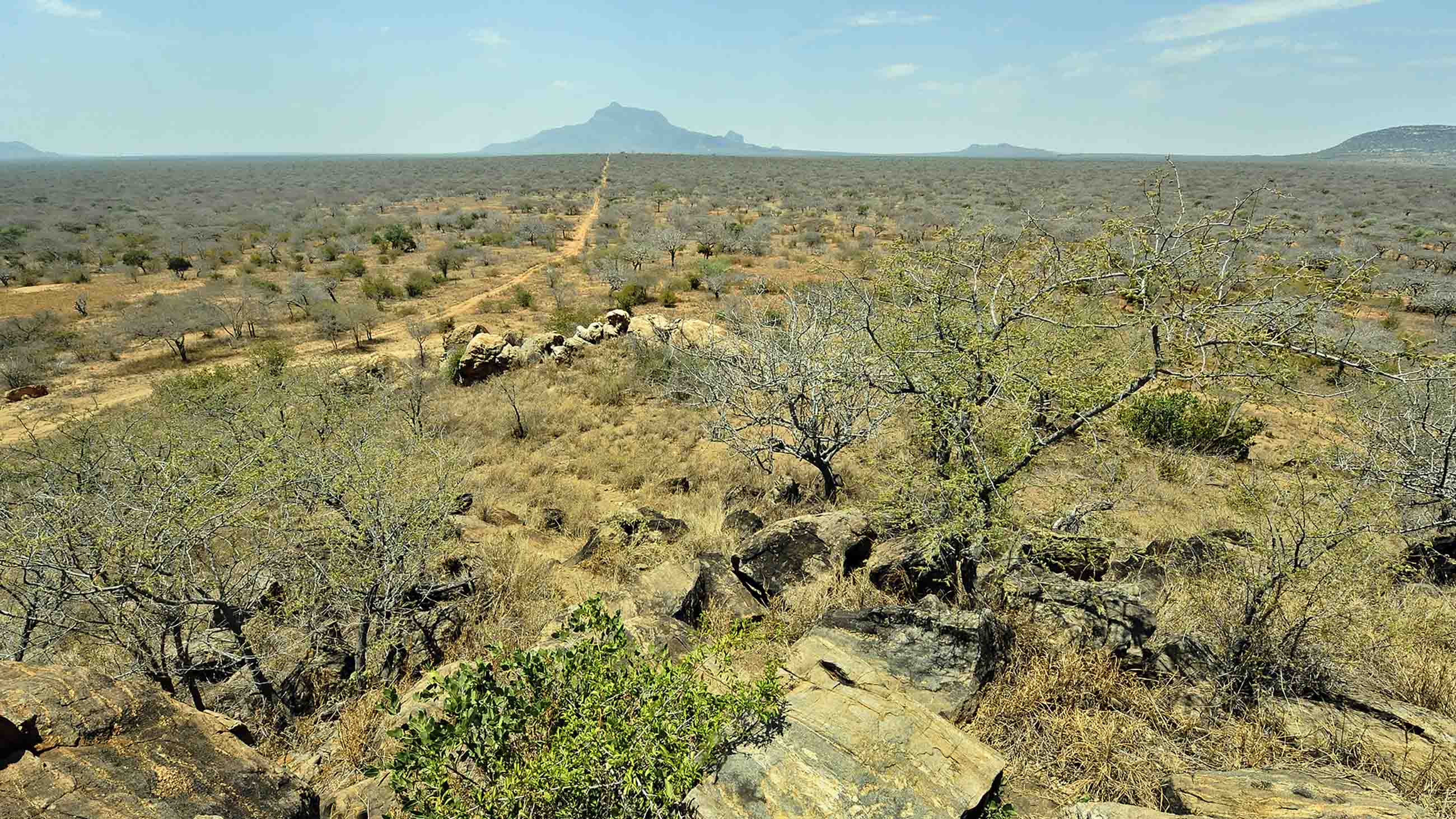
Proper implementation of REDD is necessary to help mitigate climate change, says Christoph Thies, forest policy coordinator with Greenpeace. But there are also “many pitfalls and dangers” that could lead to biodiversity loss, threats to indigenous rights and other human rights and livelihoods, and fake climate benefits, he says.
One concern with smaller private REDD initiatives is that they may push illegal tree cutting and charcoal burning outside a project’s borders. According to Korchinsky, however, Wildlife Works’ last two audits found that deforestation outside of the project area was equal or less than what it was prior to the start of the project.
Another uncertainty is what will happen when the 30-year contract of REDD agreements contract expire. Will there be enough economic development and jobs to preserve the forest and wildlife? Or will people once again resort to cutting down trees and hunting animals? In the near-term, global environmental policymakers emphasize the importance of large, national level projects. UN REDD, a joint program of the United Nations Environment Program (UNEP), UN Development Program and the Food and Agricultural Organization, promotes REDD projects that span entire counties or provinces in order to control deforestation.
To avoid leakage, Thies of Greenpeace says REDD must be broadly embedded within national commitments to protect forests and strengthen forest people’s rights and livelihoods. Large government-backed REDD projects that sell carbon credits to other governments in bulk can more effectively tackle worldwide deforestation and emissions, he suggests.
At the same time, these big projects can become unwieldy and complicated to implement. “The time to generate results for these larger schemes is unfortunately longer, but we hope [they] will be more sustainable,” says Ivo Mulder, who served as REDD+ Green Economy Adviser with UNEP at the time of my interview. (He has since become finance and private sector coordinator with UNEP’s Terrestrial Ecosystem Unit.)
As Wildlife Works is a private project, it has no formal link with UN REDD. And according to Mulder, a plan for incorporating this type of activity into an overall national strategy has not yet been determined.
Worldwide, nearly $10 billion has been pledged to REDD projects, about 90 percent of which is for government-to-government projects. Still, there isn’t enough voluntary demand, which is usually driven by corporate social responsibility.
Voluntary sales depend on global economic security and prosperity; otherwise income slumps. Estimates indicate that at least $20 billion annually is needed to halve global deforestation. Norway, the US, Germany and Japan are the biggest funders for national projects, and Indonesia and Brazil the largest recipients. However, these big REDD projects are still being implemented.
Only about one-third of funding for approved programs has been disbursed between 2010 and 2014. “I am hopeful that as the full $10-plus billion is spent and we start to see more reporting on the full range of REDD results, — emissions reduction, governance reform, biodiversity, etc. — more funding will become available,” says Marigold Norman, a senior adviser for the Washington DC-based non-profit Forest Trends.
The landmark Paris Agreement signed at the United Nations climate change summit in December 2015 seemed to bode well for REDD: the global climate treaty recognized REDD as a way to reduce emissions. And the market for carbon credits looked set to grow after 2020 when signatory countries agreed to start reducing emissions — though that outlook has become less rosy with the election of U.S. President Donald J. Trump, who vowed to pull the U.S. out of the Paris agreement altogether.
Yet there are shreds of hope. “Cities and states across the U.S. could partially offset the gap” left by the federal government, says Mulder of UNEP. He also points out that a large portion of REDD funding comes from European countries. If they remain committed, that could be enough “motivation [for] developing countries to reduce emissions.” Agribusinesses and retailers can also play an important role through platforms such as the Consumer Goods Forum where companies try to offset the impact of deforestation.
Greenpeace’s Thies cautioned against using carbon credits to offset emissions because every sector needs to do more to mitigate climate change. “Incentives and support from industrialized countries to implement REDD must instead come from public sources,” he wrote in an email. And it’s not just poor countries that must preserve forests. The U.S., Europe, Canada, Russia, Australia and others all have large forest areas and must do much more to protect and restore them.
Meanwhile, far from the halls of power in rich countries where complex policies are hammered out, life goes on in rural Kenya.
Marasi Primary School sits off the Nairobi-Mombasa highway near Rukinga Sanctuary. On a hot afternoon, students are still at their desks even though it is late in the day. They cheer in ecstatic excitement when we visit their classroom. Victor Wambua Masai is the school’s head teacher. A few years ago, classrooms for 600 students were falling apart, he explains. Rain poured through holes in decrepit roofs. With carbon credit money, the school’s walls, roofs, and doors were repaired. Classrooms are simple and threadbare, but now buildings are solid.
Wildlife Works is cautious about doing work that the government should do, Dodson said, but he lamented there are too many gaps left behind by Kenya’s inefficient government.
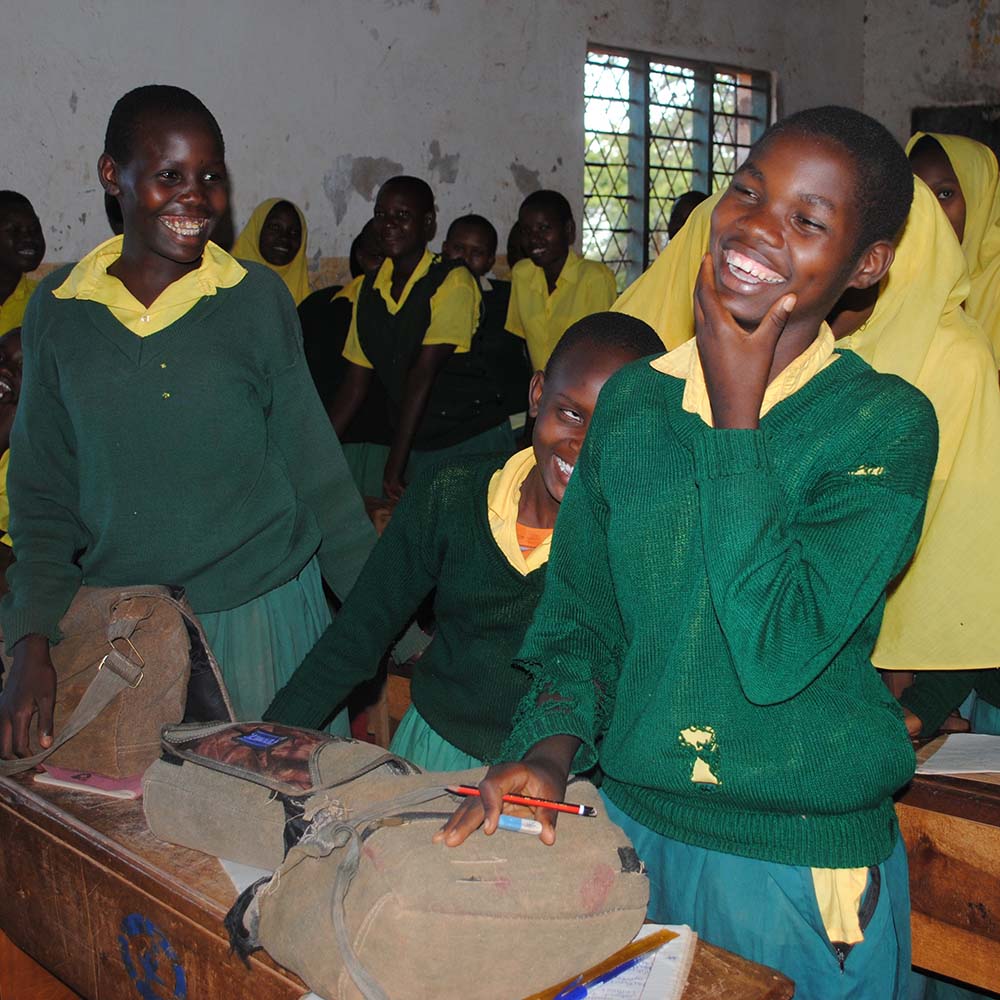
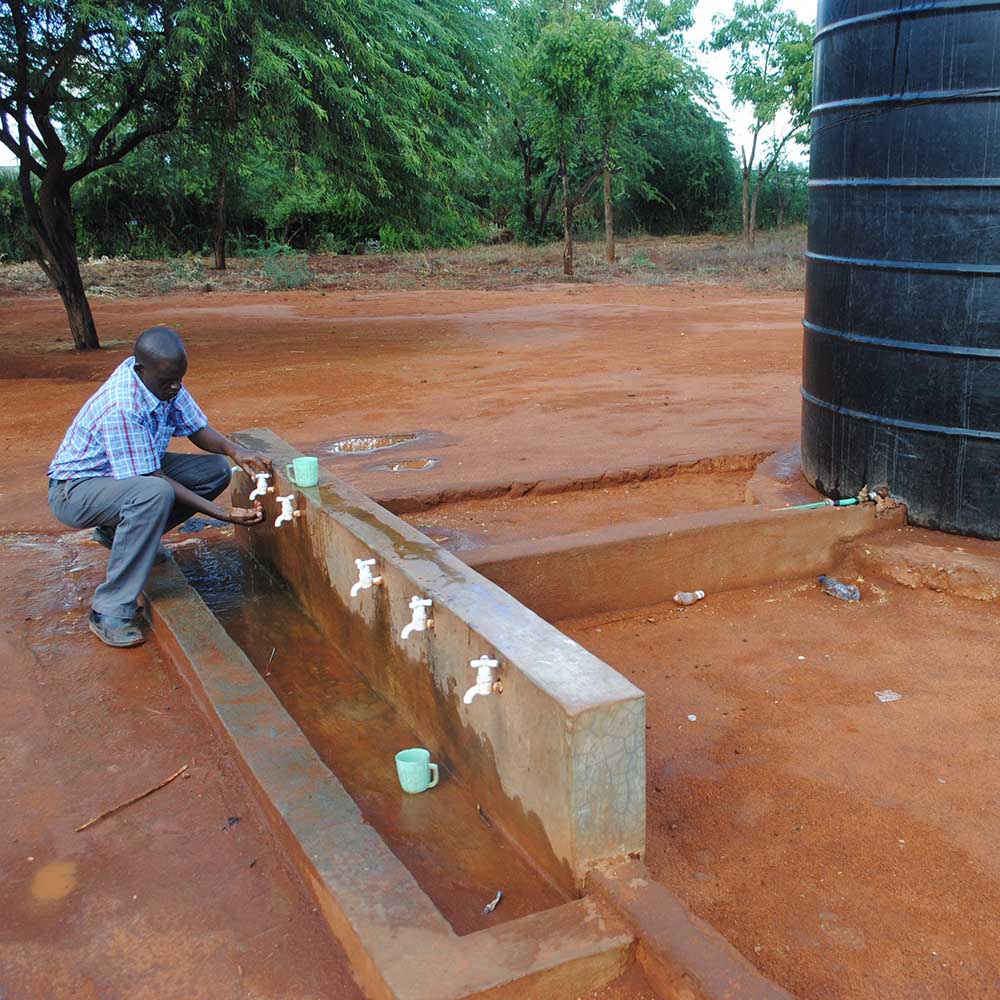
Until recently, most local children did not finish high school due to high tuition and pressure to work and earn money for their struggling families. But through Wildlife Works, more than 3,200 students have been awarded some $260,000 in high school and higher education scholarships. In 1998, there was little chance for young people to enroll in college or other tertiary institutions. Now hundreds of local youths attend college, like Muasa Mwololo.
I meet Mwololo next to his modest home near the gate leading to Wildlife Works. We sit on tiny wooden stools underneath a tree offering shady respite from the afternoon heat. An armored cricket — a large crab-like insect — creeps over the packed dirt near our feet as we talk. Mwololo is quiet and speaks slowly, but he is open when talking about Wildlife Works.
Mwololo had to drop out of school after his mother died when he was 10. He grew up near Wildlife Works and hung out nearby after he was orphaned. Dodson noticed the hungry child. Mwololo’s grandmother could not pay for him to go to school, so at age 14 he did odd jobs. At the time, Wildlife Works hadn’t yet started selling carbon credits and did not have a formal scholarship program, but still paid for his tuition so he could return to school. Without that support “maybe I would have ended up being a street child,” Mwololo says bluntly.
When Korchinsky first met Mwololo, “He could not look you in the eye at all, he had a terrible stammer,” he recalls. “[He] had no self-confidence at all.” However, Mwololo had an uncanny memory for details.
The young man says that Korchinsky promised Wildlife Works would send him to university when carbon credit earnings came through. A few years later, Mwololo ended up studying environmental science at Kenyatta University in Nairobi, though he had to defer his studies for two years after his wife had two children. Today he helps lead Wildlife Works’ forest plot sampling. Mwololo’s sharp memory is an asset in his work. “He is very impressive to external auditors,” observes Korchinsky, “as he can remember almost every tree on every plot he measured.”
Mwololo adds: “Wildlife Works has done a lot for the community.” A friend of his attends university on scholarship. Water pipes and catchments were constructed and schools have been built or repaired. He also recalls that when he was growing up, there were no animals around Rukinga Sanctuary. Now elephants are a common sight even along the long dirt road leading to Wildlife Works’ office.
Carbon credits have financed precious new jobs. More jobs at Wildlife Works as seamstresses, tailors, greenhouse workers, mechanics, office staff, and rangers means people have alternatives to poaching and charcoal burning for earning money. In 2010, before REDD, Wildlife Works had 65 employees. In 2017, it counted over 300, and it was the county’s third-largest employer after the Kenyan government and a large sisal plantation.
Each morning, local women and men walk up the hilly road leading to Wildlife Works and the small garment workshops on its grounds. Women can leave babies and toddlers at the on-site nursery school while they make clothes for local boutiques and fair trade shops in the U.S. The workshop floor is airy and bustling. Women chat while running sewing machines and cutting bolts of fabric on wide countertops.
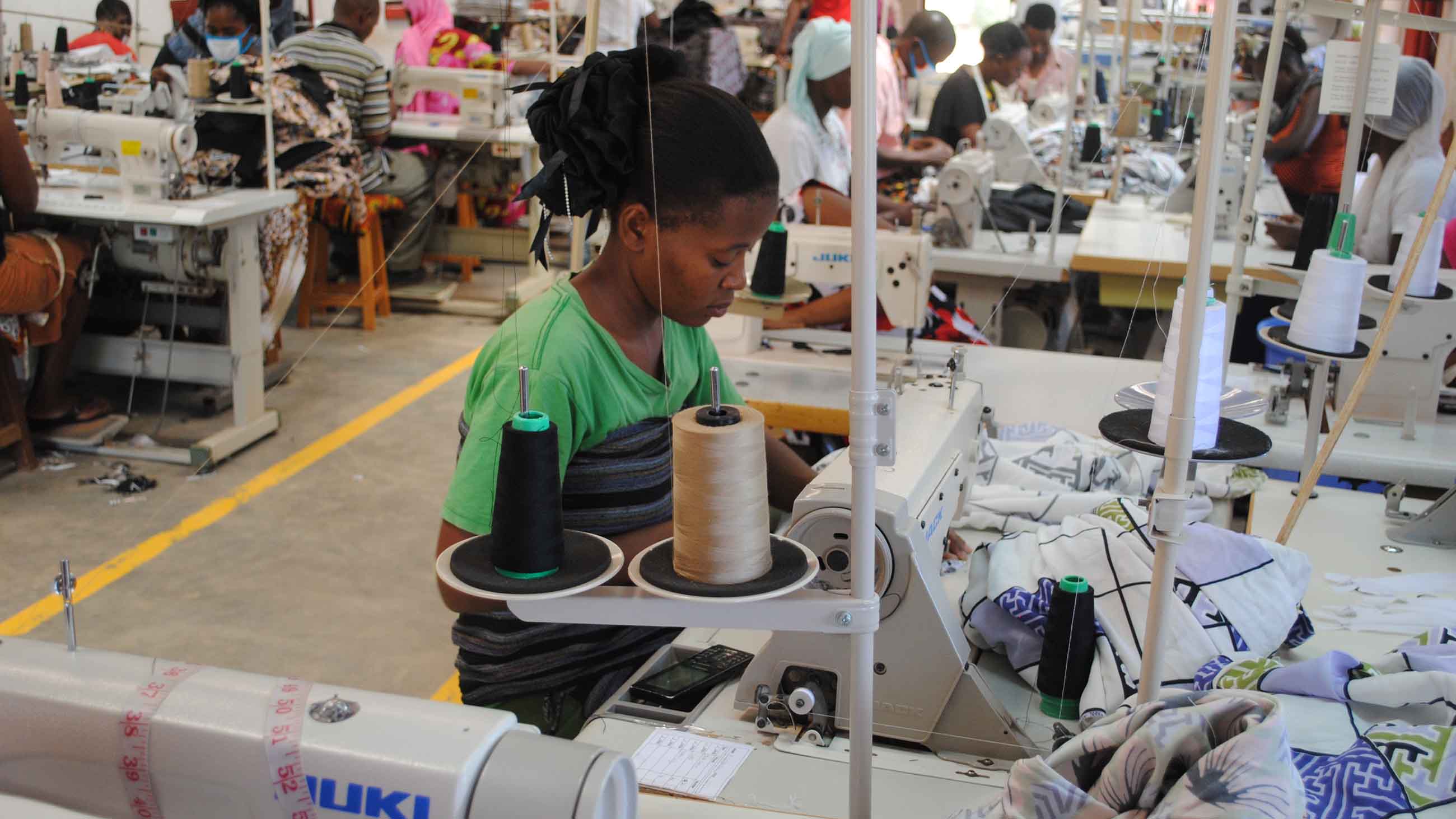
Jobs like these have “certainly allowed young women to see that there are alternatives out there to bar work and prostitution,” said Dodson. I recall that the highway sex worker who offered sex for $2 was not from the area but another town up the road.
More jobs also means better protection for wildlife. Before carbon credits in 2010, Wildlife Works had 15 rangers hired from local villages; now more than 100 rangers patrol a far larger area every day. Better patrolling is key to fighting poaching.
Wildlife Works’ rangers patrol on foot every morning from eight stations spread out over nearly 500,000 acres of the Kasigau Corridor. At a bush station a couple hours’ drive from Wildlife Works’ headquarters, rangers wake in the early morning and eat a breakfast of boiled eggs and bread brought by visitors — a change from ugali, a stiff cornmeal porridge ubiquitous in Kenya. We drive through a dry landscape covered with acacia trees. As we bump along narrow dirt trails, the acacias’ long thorns scratch our faces through the open jeep.
We stop and set out on foot to cover a transect spanning a couple miles. As we tramp in silence across the dry landscape, branches and thorns snag my sleeves. The sun begins to burn down on us. There’s no sound except whistling wind and the crunch of footsteps on dry dirt. Through the brush, we glimpse a herd of scattering zebra cantering through the bush. The heat is getting oppressive and before long I drain my water bottle. The rangers don’t carry any water in order to remain unencumbered; they drink at the end of their patrol from a huge tank carried by one of the vehicles. They scan the landscape for poachers’ makeshift camps — signs of a fire, discarded food packages and bottles. If the rangers find packaging for spaghetti, that’s a sign of poachers from Somalia, which was occupied by Italians who left their influence on the country’s cuisine. The patrol is uneventful but at the end, a ranger stops to examine some undergrowth. He has spotted a snare — a loop of wire meant to trap antelope like impala or dik dik.
Snares like these used to be frighteningly common. They dotted the landscape like death’s ornaments. Rangers used to find about 8,000 a year. They found so many snares that Wildlife Works used tens of thousands of them to make a massive life-size sculpture of an elephant that sits on a bluff at a nearby hotel. In stark contrast, these days, rangers find only about 300 a year.
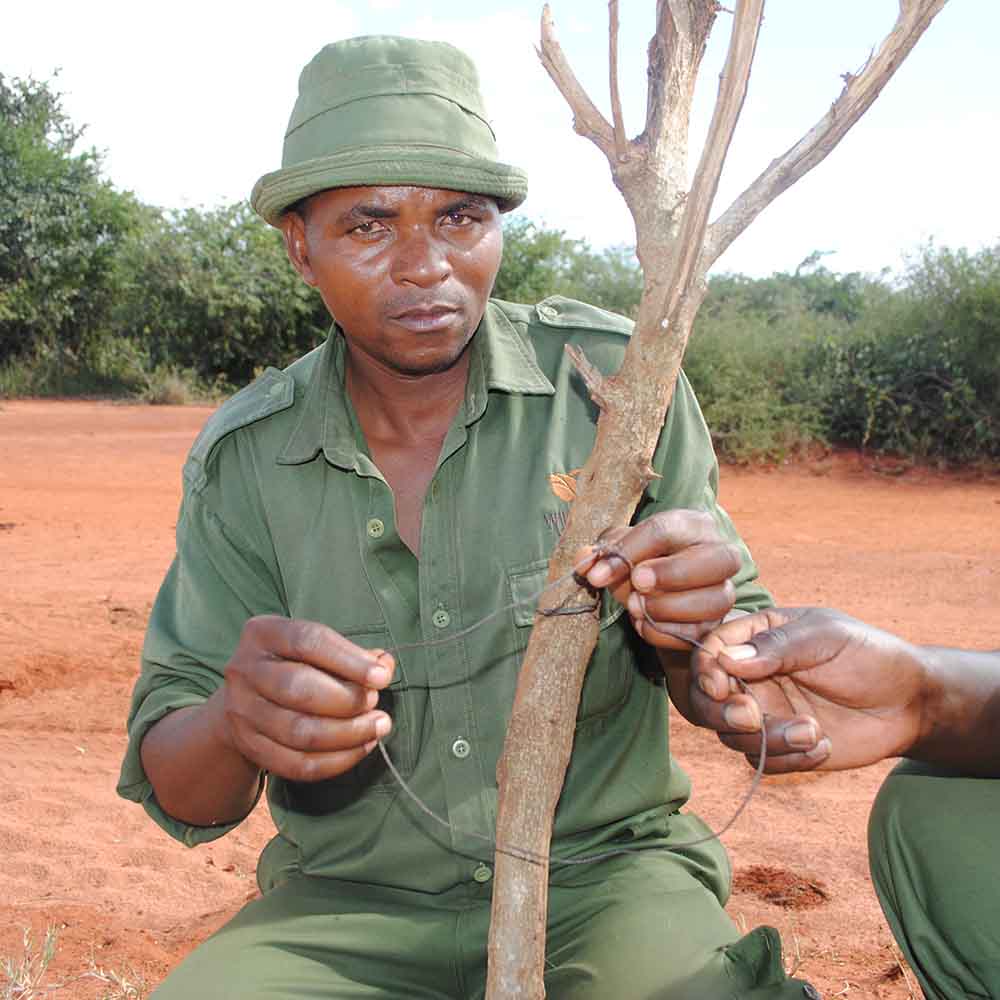
A Wildlife Works ranger holds an animal snare he found on a patrol in the Kasigau Corridor in southern Kenya. Snares like these used to be frighteningly common.
Visual: Amy Yee
Stiffer government penalties for poaching elephants and bushmeat, collaboration with the government’s Kenyan Wildlife Service and a larger, better-equipped team of Wildlife Works rangers has all led to the dramatic decrease in both snares and poaching in the Kasigau Corridor. In 2014, at least 27 elephants were killed for ivory in the corridor compared to four as of mid-2016.
Carbon credit earnings let Wildlife Works buy vehicles and equipment to patrol more effectively. In 2010, there was one vehicle; now there are four Toyota Land Cruisers to get around the vast expanse of shrubby forest. Wildlife Works rangers are unarmed, but they collaborate more with the government’s armed Kenyan Wildlife Service officers, who primarily patrol protected national parks and reserves. KWS has also strengthened due to more focus from the government and additional funding. Kenya dramatically tightened laws and penalties against poaching in 2014. Previously, ivory poachers could get away with paying a $400 fine. Today, the highest penalty is $192,000 or life in prison.
Most of Wildlife Works’ rangers have limited education. In fact, one-third of them are former charcoal burners and poachers who previously had few prospects for employment. Wildlife Works created coveted stable jobs for people who support a bevy of family members and relatives. These local bushmeat poachers are driven by poverty and the need to feed their families; their profits are slim. They normally don’t hunt elephants because of the harsher penalties and greater danger of killing a seven-ton animal. Elephant poachers in the Kasigau Corridor tend to be outsiders from neighboring Somalia, said Dodson.
One poacher turned gamekeeper is 30-something Ayub Vura. He wears a dark green uniform and though he has a mild demeanor, he is one of Wildlife Works’ best trackers. Vura’s stellar bushcraft was honed when he started poaching as a child near his hometown south of the Kasigau Corridor. During adolescence, he helped his uncle hunt animals at night. Today, there are no animals left in his home area, Vura observed. In fact, there are also virtually no trees there; they were cut down to make charcoal. The landscape is a barren wasteland.
Before Vura became a Wildlife Works ranger seven years ago, his life was very different. With his eighth-grade education, he couldn’t find work and couldn’t afford to feed his family or send his children to school. The only way to make money was poaching wild animals or burning charcoal. One dik dik, the smallest antelope, would fetch 100 shillings, about $1, says Vura. He sold the meat at market and kept only the heads and intestines for his family to eat.
Vura used to hunt twice a week at night with three other accomplices who carried food, water, and poached meat. Instead of snares, they used bright flashlights to blind animals, freeze them in their tracks, and cut down their legs with machetes. They didn’t always catch animals, though a good haul could be as many as ten dik diks in a night. Poachers walking through the bush in the dark had to avoid the perils of elephants, wild buffalo, and snakes. It was dangerous, hard work and they endured heat, thirst, hunger, and exhaustion.
In 2006, Wildlife Works rangers caught Vura poaching. He was charged and ordered to serve three months in jail or pay a 5,000 shilling ($50) fine. Vura spent several days in a rudimentary jail cell with no toilet and bedding before relatives scraped together money to pay the fine to release him. That experience in prison shook Vura so he decided to stop poaching — and took up charcoal burning instead.
This work was also arduous and time-consuming. Vura had to cut down and chop an acacia or other hard wood tree into pieces. Then he had to cut down more trees to burn the wood in a covered earthen pit for several days to carbonize the acacia into charcoal. It took three to five weeks to make half a dozen bags of charcoal that he sold for 150 shillings ($1.50) or less. All the while, Vura had to avoid rangers and endure treacherous conditions in the bush.
One day, in a local chief’s office, Vura saw a notice that Wildlife Works was recruiting rangers. Eric Sagwe, head of security at Wildlife Works, was surprised when the man he had caught poaching turned up at a recruitment session.
“Are you sure you want to join?” he asked.
Vura replied he had no other way of feeding his family. “If you offer me a job, you will never see me in the bush,” he said. After passing a physical exam, he was hired by Wildlife Works.
Vura’s decades of poaching are now a boon for Wildlife Works. Now he is “our number one tracker. He knows every track,” Sagwe says proudly.
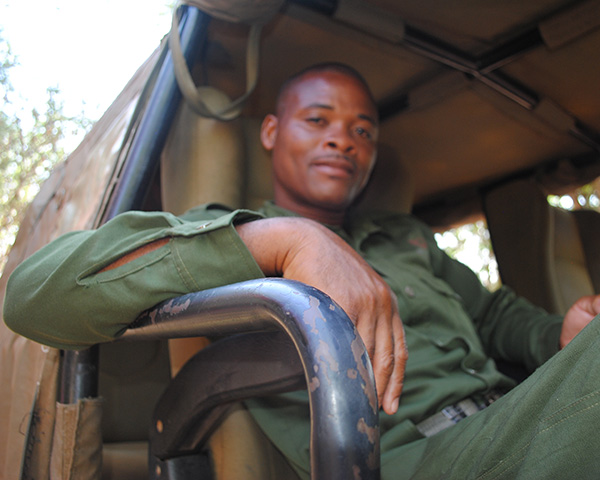
Ayub Vura spent decades as a poacher. Now he’s working on the other side.
Visual: Amy Yee
Today Vura makes over $200 a month, not including overtime, food and other allowances. It’s a good, stable salary for someone in rural Kenya with limited education. The work can be dangerous. In 2012, ranger Abdullahi Mohammed was fatally shot by elephant poachers. Another ranger, Ijema Funan, was shot and injured in the same attack.
Yet Vura says his job is easier and far more stable than his work as a poacher and charcoal burner. The steady salary of a ranger lets him enroll his children in school. He also bought some livestock and replaced the thatch roof of his house with a metal one. “I want my kids to have proper education,” says Vura. He’s imagining university for them even though tuition is expensive in Kenya.
Vura also notes there has been a visible change in the landscape in Kasigau Corridor. Before, you could go long distances and not see animals, he remembers. Things have changed. “Now animals are moving everywhere. The number of trees has increased. It’s become very bushy and green.”
Being a ranger is not just about catching bad guys. As the sun begins to set, a Wildlife Works’ ranger named Mike Renson drives the jeep over dirt trails between an endless swath of acacias. He barrels confidently down paths that are barely discernible as roads. We take a detour and halt at the edge of a field where an elderly man waits for him. Renson gets out of the car, speaks to the man, then gives him a small brown paper bag. This is medicine for the old man who lives far from town. These acts of good will earn trust among locals.
In exchange, they tell rangers about illegal activities or if any suspicious ‘outsiders’ appear. We wave goodbye, then set off again through the acacias, racing against the setting orange sun to return to camp before darkness falls.

Keeping trees from becoming charcoal or firewood here is an enormous conundrum. Charcoal is carbonized wood that burns longer and hotter than regular wood. Wealthier people cook with gas, but most rural people in this area rely on wood for day-to-day cooking fuel and they sell charcoal to make money. Alternative fuel such as methane from biogas created by human and animal waste is scant in Kenya. Innovation and new initiatives are sorely lacking. It’s far easier for someone to chop down trees for wood or to buy charcoal sold abundantly in local markets.
Wildlife Works does use biogas for its staff kitchen. Large pillow-like sacks are full of methane captured from animal waste; the odorless gas is then piped into the kitchen. It also trains people on how to use energy efficient stoves that burn a fraction of the amount of wood used by a traditional stove, as well as pyrolytic stoves that use small sticks for fuel. Wildlife Works is considering how biogas could be used at schools where hundreds of students use pit toilets whose methane goes unharnessed. These same schools buy tons of wood each year to cook students’ breakfasts.
In 2014, carbon credit income helped Wildlife Works start a pilot program to make “eco-charcoal,” where wood is harvested systematically and turned into charcoal using more efficient techniques. Over an area of three square miles, trees are trimmed and branches are snipped off with cutters in a way that doesn’t damage the tree. By comparison, traditional charcoal making requires wood to be burned in a dirt-covered pit for a couple days using wood from two or three felled trees.
In contrast, to make eco-charcoal, branches are burned for a few hours in sealed oil drums where combustion is incomplete. Acid and other elements evaporate so carbon remains. Around 200 pounds of branches produce 70 pounds of a crumbly mixture of blackened wood called biochar.
Using a shovel, a Wildlife Works employee in a dark blue jumpsuit mixes this brittle detritus with cassava, then shapes it using a large metal press. He tamps down the biochar into the mold, then acrobatically uses his body weight to pull a lever and squeeze the blackened matter into briquettes. One briquette sells for 10 shillings, about 10 cents. Regular charcoal costs about 11 shillings. However, supplies of eco-charcoal are relatively small, so it remains a specialty item used by eco-conscious hotels and restaurants.
Martin Nyambu, who passed away late last year, was an environmental scientist who oversaw Wildlife Works’ eco-charcoal project. He grew up in the area and said the landscape has changed dramatically. When we met, he spoke quickly and passionately.
“When we were growing up you could see wildlife all around and in the evening moving around. You could see large trees. There is no more water flowing in the river…Nowadays we only see dry riverbeds,” said Nyambu.
“Ground recharge is very low,” he continued, “meaning that sooner or later, the aquifer will also be affected. If there’s no ground recharge, where are we going to get the water?”
Digging deeper and deeper holes to access water may provide a temporary solution, but Nyambu warned that sooner or later, this would have an effect. “What we can do now is try to utilize what is there sustainably for current use. Of course we can’t stop using resources. Let’s try to wisely use our resources for the current generation and future generation,” he implored.
On weekday mornings, a loud buzzing pierces the air over Rukinga Sanctuary as a gyrocopter takes off from Wildlife Works. The lightweight copter looks like a large eggshell attached to rotor blades. It trundles down a dirt airstrip, and ascends weightlessly into the air for daily patrols over the Kasigau Corridor.
One morning, pilot Keith Hellyer guided the gyrocopter south, but a woolly blanket of fog obscured his regular route. He swooped in another direction and flew more than 10 miles where he spotted a herd of at least 40 elephants meandering across the bush below. Hellyer saw something else on the ground — the distinctly patterned body of a giraffe. Blood pooled and darkened the soil. It wasn’t a lion’s kill since the carcass was cut into neat pieces — legs, trunk, neck. A half mile away, Hellyer saw a second slain giraffe. Branches covered the body in an attempt to obscure it from view. As he steadied the gyrocopter high above the giraffe, Hellyer could see footprints and motorbike tracks leading away from the carcass. He radioed Wildlife Works and rangers quickly drove to the site. Kenyan Wildlife Service rangers were also alerted and dispatched.
Wildlife Works ranger Moses Lorewa soon arrived at the scene. The first giraffe killed was a female around 15 years old. The second was an older male, perhaps 30 years old. Blood oozed from their severed necks and heads. Rangers estimated that the poachers had struck around midnight. They carried as much meat as they could on the back of a motorbike. The poachers couldn’t carry all the meat, so left most of the male giraffe intact. His back legs were chopped off and the red sinewy flesh of his body was slashed open and exposed. The other poachers probably got away by catching a rickety matatu, or local bus, south down the Nairobi-Mombasa highway. In one of the towns down the road, the giraffe meat would be chopped up and sold in the market, indistinguishable from the other bloody cuts sold in small wooden stands covered with flies.
Lorewa regrets they didn’t spot the poachers’ tracks when they entered the bush. “We could have ambushed them,” he laments. Giraffes never attack humans or raid farms, Lorewa adds. They are peaceful animals that just graze in the bush. “I felt sad actually,” he says.
Previously, rangers found giraffe carcasses caught in tall snares set in trees. Sometimes, only their dismembered legs and dangling necks remained. The gyrocopter and ranger patrols, tougher laws, and government enforcement and support have all helped. There used to be “so many snares,” recalls Lorewa. After Wildlife Works expanded and intensified patrolling, poaching was drastically reduced. There was a span of seven weeks in 2015 when Wildlife Works rangers didn’t find a single snare.
There is also less charcoal burning, although tell-tale fires can be spotted often during gyrocopter patrols. “If people are desperate, they will take different risks,” says Hellyer.
There’s also another threat to wildlife and humans: a 290-mile railway between Nairobi, the capital, and the port city of Mombasa, that cuts through Tsavo National Park and the Kasigau Corridor. A railway built more than a century ago and a two-lane highway already follow the same route.
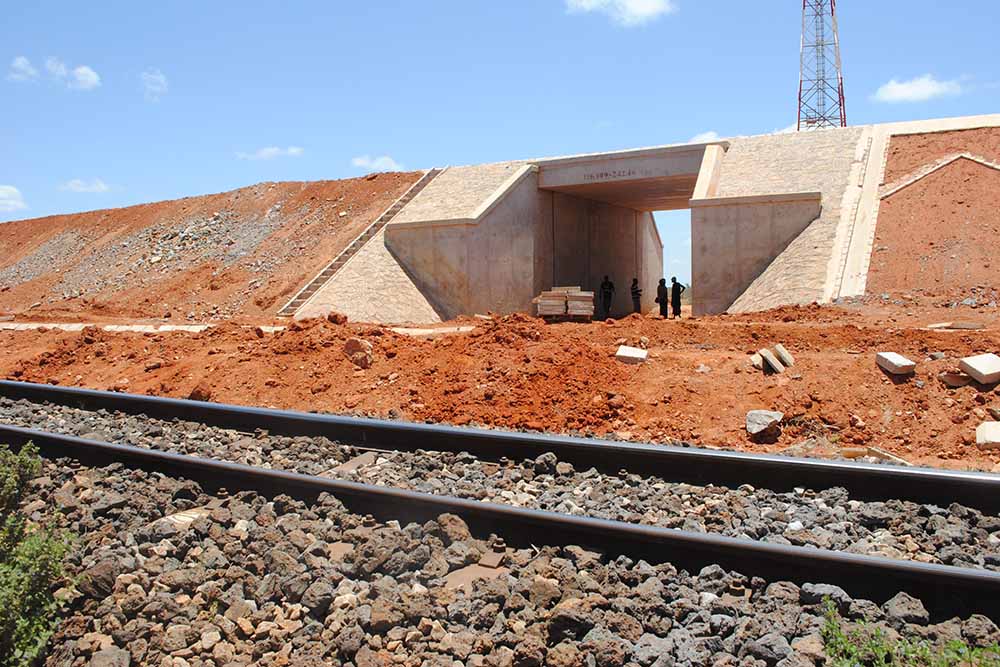
But the new railway is built on a 40-foot high elevated embankment that provides limited options for wildlife looking to pass between the two halves of Kenya’s largest national park. As a result, hungry and thirsty elephants are attacking farms and homes of locals who live among wildlife. People’s crops are ravaged and in turn, they retaliate against elephants that are destroying their livelihoods and threatening their lives. This year, Dodson recalled, an elderly woman was killed next to her home by a marauding elephant. In one town, a curfew commands school children to return home by 3 p.m. Last year, three elephants were killed by poisoned arrows by retaliating locals. The area is experiencing its worst ever human-wildlife conflict.
“It’s really, really bad,” said Dodson. Human-wildlife conflict is “going to be very much a part of our lives in the next few years.”
With more infrastructure development and a growing human population, advocates say, Kenya’s government must work with conservationists to develop underpasses, overpasses, crossing points and elevated roads for the country’s roaming wildlife. “It can be done. It’s just money,” said Dodson who emphasized mitigating human-wildlife conflict. “The big focus for Wildlife Works is working with the community, so development isn’t stopped, but rural people don’t suffer.”
In Kenya, the fight to protect wildlife, trees and the environment is an ongoing battle. The future is tenuous, but one thing is certain here: Human lives must be improved for the forest and its animals to have a chance of survival. People and wildlife must find ways to coexist.
For now, the tide seems to be turning against poaching and deforestation in the Kasigau Corridor. Pascal Kizaka, the retired local chief, lives in a village not far from Mount Kasigau, which looms over the vast bush.
Not long ago, trees were being decimated to produce charcoal. Now, the canopy has flourished and animals have returned. At a local water hole, a herd of elephants appear as the sun begins to set into a plum-colored sky. There are large bulls, females with pendulous teats, and knee-high babies who linger near their mothers. They silently surround the water’s perimeter; their soundlessness is remarkable for animals of their immense size. Some of the elephants raise their trunks toward our parked jeep like quivering, olfactory periscopes.
Antelope, giraffes, and other animals also now live among the trees and nourish themselves on the vegetation. Remarkably, even lions have returned to the area, including two big-maned males spotted lounging languidly, still as sphinxes, near a water hole during a ranger patrol.
“I could take a small trip into the bush and see a herd of giraffes,” says Kizaka who remembers it was hard to spot a single giraffe before. “The area has really changed.”
Amy Yee is an award-winning journalist who has written for The New York Times, The Economist, NPR, The Wall Street Journal, The Nation and more. She is a former staff reporter and correspondent for the Financial Times in New York and New Delhi. Amy was based in India from 2006 to 2013.










